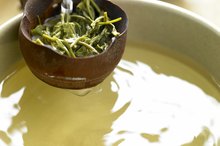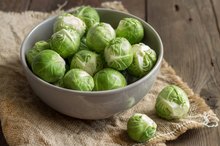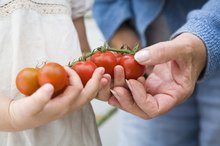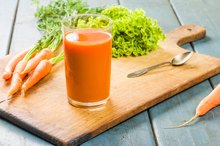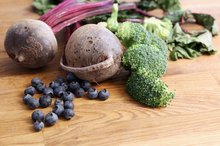List of Alkaline Fruits & Vegetables
Improving your acid-alkaline balance may decrease your risk of headaches, bone loss and other health problems. These issues may occur when your body is too acidic. Some harmful bacteria, fungi and yeasts thrive on the acid in your body. Consuming more alkaline foods may help balance the body's pH. Talk with your physician if you are concerned about the pH balance in your body and discuss any changes you make in your diet.
Definition
The pH scale ranges from 1 to 14. Acidic foods, such as lemons, have a lower number while alkaline foods, such as bananas, have a number closer to 14. Neutral foods are around 7 on the pH scale. Your diet should consist of up to 80 percent alkalizing foods, suggests naturopath Dr. Christopher Vasey. Eating more alkaline foods may help reduce the production of acid in your body. Foods classified as heavy alkaline foods have a pH of 8.5 to 9.0. Food considered moderately alkaline have a pH of 7.5 to 8.4 and lightly alkaline foods have a pH of 7.0 to 7.4.
- The pH scale ranges from 1 to 14.
- Foods classified as heavy alkaline foods have a pH of 8.5 to 9.0.
Fruits
Alkaline Indian Foods
Learn More
Fruits that are heavily alkaline include watermelon, cantaloupe, mangoes, pears, grapes and passion fruit. Dried fruits like dates, apricots, figs and raisins are also considered heavy alkaline foods. Apples, fresh apricots, bananas, berries and avocados all have a moderately alkaline pH of around 8.0. Light alkaline fruits include cherries and peaches. MyPyramid.gov recommends eating a total of 1 1/2 to 2 cups of fruit throughout your day, and selecting alkaline fruits can help balance your body's pH.
- Fruits that are heavily alkaline include watermelon, cantaloupe, mangoes, pears, grapes and passion fruit.
- Apples, fresh apricots, bananas, berries and avocados all have a moderately alkaline pH of around 8.0.
Vegetables
You should consume 2 to 3 cups of vegetables each day, MyPyramid.gov notes, and adding more alkaline vegetables can help balance out acid in the body. Vegetables that are high in alkaline include endives, asparagus and alfalfa sprouts. Moderately alkalinic veggies include celery, sweet potatoes, pumpkin, corn, carrots and turnips. Cucumbers, leeks, mushrooms, okra, onions and artichokes are considered lightly alkaline foods.
- You should consume 2 to 3 cups of vegetables each day, MyPyramid.gov notes, and adding more alkaline vegetables can help balance out acid in the body.
- Cucumbers, leeks, mushrooms, okra, onions and artichokes are considered lightly alkaline foods.
Considerations
How to Raise Body pH Level Quickly
Learn More
Additional high alkaline foods that may help your pH balance include parsley, 100 percent vegetable juice, garlic and ginger. If you are trying to balance your body's pH, you need to make changes to your diet as a whole. Consuming a few alkaline fruits and vegetables once in awhile may not create the changes you desire. Including alkaline fruits and vegetables as part of an overall balanced diet may be more effective than sporadically including them in the diet.
- Additional high alkaline foods that may help your pH balance include parsley, 100 percent vegetable juice, garlic and ginger.
- Including alkaline fruits and vegetables as part of an overall balanced diet may be more effective than sporadically including them in the diet.
Related Articles
References
- BetterBones.com: Acid-Alkaline Diet
- TheAlkalineDiet.org: Lists of Alkalizing and Acidic Food
- The Telegraph, "Cleanse your body with the alkaline diet." Dec. 29, 2014
- Han H, Segal AM, Seifter JL, Dwyer JT. Nutritional Management of Kidney Stones (Nephrolithiasis). Clin Nutr Res. 2015;4(3):137-52. DOI: 10.7762/cnr.2015.4.3.137
- Schwalfenberg GK. The alkaline diet: is there evidence that an alkaline pH diet benefits health?. J Environ Public Health. 2012;2012:727630. DOI:10.1155/2012/727630
- Remer, T et al. Potential Renal Acid Load of Foods and its Influence on Urine pH, Journal of the American Dietetic Association, Volume 95, Issue 7, 791 - 797 DOI:10.1016/S0002-8223(95)00219-7
- Dawson-Hughes B, Harris SS, Ceglia L. Alkaline diets favor lean tissue mass in older adults. Am J Clin Nutr. 2008;87(3):662-5. doi: 10.1093/ajcn/87.3.662
- Fagherazzi G, Vilier A, Bonnet F, et al. Dietary acid load and risk of type 2 diabetes: the E3N-EPIC cohort study. Diabetologia. 2014;57(2):313-20. doi:10.1007/s00125-013-3100-0
- Xu H, Åkesson A, Orsini N, Håkansson N, Wolk A, Carrero JJ. Modest U-Shaped Association between Dietary Acid Load and Risk of All-Cause and Cardiovascular Mortality in Adults. J Nutr. 2016;146(8):1580-5. doi:10.3945/jn.116.231019
- Han E, Kim G, Hong N, et al. Association between dietary acid load and the risk of cardiovascular disease: nationwide surveys (KNHANES 2008-2011). Cardiovasc Diabetol. 2016;15(1):122. doi:10.1186/s12933-016-0436-z
- Jia T, Byberg L, Lindholm B, et al. Dietary acid load, kidney function, osteoporosis, and risk of fractures in elderly men and women. Osteoporos Int. 2015;26(2):563-70. doi:10.1007/s00198-014-2888-x
- Rebholz CM, Coresh J, Grams ME, et al. Dietary Acid Load and Incident Chronic Kidney Disease: Results from the ARIC Study. Am J Nephrol. 2015;42(6):427-35. doi:10.1159/000443746
Writer Bio
Melodie Anne Coffman specializes in overall wellness, with particular interests in women's health and personal defense. She holds a master's degree in food science and human nutrition and is a certified instructor through the NRA. Coffman is pursuing her personal trainer certification in 2015.



